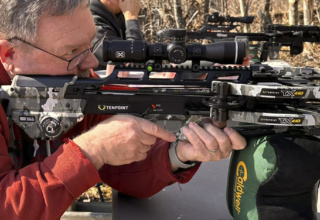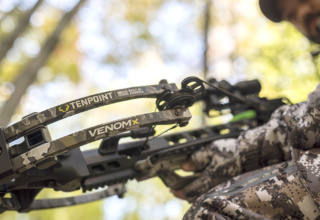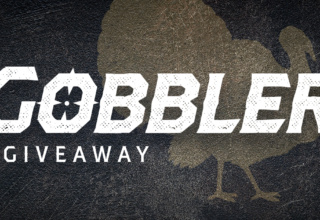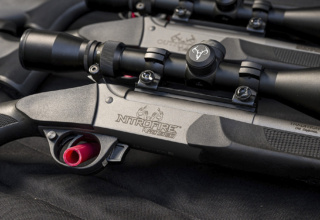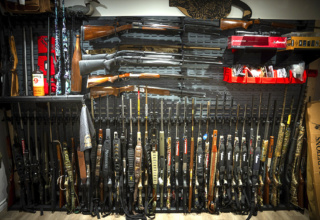A diversity of game in often surprising numbers makes the Cowboy State a prime draw for adventurous hunters
by Brad Fenson
Like most traveling hunters, I was worried about the weather and how it may impact my archery hunt for antelope and whitetail deer. With an unseasonable amount of rain, the antelope may not go to traditional watering holes to drink, and our hunt was set up on watering holes that have always worked in the past. Our outfitter, Ralph Dampman of Trophy Ridge Outfitters, softly chuckled when I expressed concern. Ralph has been in the hunting game for decades and knew the critters in his area better than anyone. If he wasn’t worried, I knew I shouldn’t waste any of my valuable time or energy fretting about the “what ifs?”
The first morning of the hunt, we were up well before the sun. We had a quick breakfast, and I opted for extra coffee to keep alert. In hindsight, I was a little wired and likely drove my guide crazy with all the questions on our 40-minute drive to the hunting area. I had chased antelope in the same area the previous year and tried to keep track of landmarks in the dark to figure out where we were going. Driving and bumping along a prairie two-track, we finally crossed a berm, where the headlights of the truck caught the silhouette of a brushed blind. It was GO time!
I grabbed my gear, sprayed down with Scent Killer Gold, and settled into the blind, perched about eight yards off the edge of a rectangular watering hole. The sights and sounds of my dark hide were unique to the open grassland. Insects buzzed and creaked, while distant red lights illuminated towers and wind-powered mills. As light crept up the eastern sky, the local birds came to life, singing for the new day dawning. A pair of teal splashed into the pond, putting me on high alert. Meadowlarks hopped to the water’s edge to get a drink, and mourning doves cooed and watered in loose groups before their whistling wings carried them away.
I had been sitting in the blind for over three hours and was still trying to picture the antelope buck that might come for a visit. The way the blind was situated left me unable to see the surrounding landscape, as the berm we had driven onto in the dark was an earth dam that created the watering hole. With limited visibility, I concentrated on the game trails that were cut deep into the earth. I knew some of the trails would have been pounded out by cattle, but the dainty footprints in the mud around the edge of the pond let me know where the locals liked to drink.
Busy daydreaming, I was caught totally off guard when the first antelope buck came for a drink. The dark-horned buck walked over the berm like he had been there a thousand times and headed straight to the water’s edge across from me. I knew he was just 27 yards because I had ranged the area earlier in the morning as one of the most likely spots an animal would drink. The buck marched straight down the hill towards me, making his horns look short. I didn’t get too excited and enjoyed the opportunity to watch the animal guzzle water like he was putting it away for a week. The antelope drank for much longer than expected and when he was done, he turned broadside for a moment. The side view of the buck made me do a double take. The horns were much taller than I first judged, and the mass was better than I expected. To top things off, one of the cutters looked like it had a split and there were extra horn growths, or knobs, growing off both sides. My heart raced with anticipation knowing the buck wouldn’t stick around long. My initial judgment of the horns was wrong, and now I was scrambling to try to get into position for a shot.
The antelope trotted to the top of the berm, and I thought for sure it would disappear. The vantage point, though, made the old warrior pause to overlook his territory. The buck then lowered his head and started to rack his horns and cheek glands on a large sagebrush. The air was dead still, which is unusual for Wyoming. Normally, the wind always blows, but today it was silent.
I leveled the crosshair of my TenPoint Stealth NXT crossbow on the antelope’s vitals, ranged the spot where the white and tan hair came together on the buck’s side, and slowly pulled on the trigger. The antelope was busy trying to shred the sage, and when I sent my arrow on its way, the buck spun and took off. The SEVR broadhead and arrow disappeared into the side of the animal, and it was gone out of sight in a blink.
I never dreamed the first buck into my watering hole would be a shooter or that an antelope would even show up on the first day, given all the rain Wyoming had experienced. I was shaking as if I’d just drained a Thermos full of coffee. After waiting 20 minutes, I emerged from my blind to check on the buck.
Scurrying around the pond on the cattle trails was like walking on a concrete sidewalk, putting me on top of the berm, where the largest sagebrush was broken and shredded on one side. White and tan hair was spread on the ground, and I walked off the far side, trying to find blood. The buck had spun and run so fast that I was not sure where the blood trail would start, but before I could locate the spore, I spotted white hair behind some sage about 30 yards away. The buck had not gone far.
The old prairie goat had more character than any antelope I’d ever taken. The buck could almost be described as non-typical with the extra growths and split horn at one of the cutters. This was a mature buck I was thrilled to tag.
We switched gears quickly, got the antelope put away in a cooler, and headed out to set up for an evening whitetail hunt. My Wyoming deer license entitled me to a whitetail or mule deer, but most bucks in the area were good old whitetails.
Ralph has dozens of ground blinds and treestands set up to take advantage of different wind directions, deer movement, and to hunt prime travel corridors between bedding and feeding areas. The one thing I learned to appreciate were the ALPS OutdoorZ Stealth Hunter Blind Chairs. They are fully adjustable for any terrain to keep the shooter level with the window and never struggling to stay comfortable.
Wyoming is an exciting place to hunt whitetails, as the population of deer is mind-boggling. The open grasslands may conjure up images of mule deer, but the sweeping foothills in the northeast part of the state are prime whitetail habitat that extend out of the Black Hills of South Dakota.
As I crawled into a blind hidden on the edge of a treeline, the deer were already starting to funnel out. Ralph spends more time watching his deer than anyone else I know. It allows him to set up blinds and stands within bow range of the big bucks moving naturally along their regular trails to feed. To say it’s always a show would be an understatement. There are often more deer sightings in one evening than some people would see in an entire season. I enjoyed watching over 200 whitetails but didn’t have anything wander to within crossbow range.
The next morning, I was climbing steep, pine-covered hills to cut off deer heading to prime bedding areas. Long before legal light, the deer started to funnel down two trails below the blind, and they were close. One nice buck walked with a doe just 28 yards from the front window of my hide, but it was still too early to shoot. Some mule deer also worked the ridge and cut up behind the blind. Everything was going great until the first buck that passed winded me. The snorting, blowing, and scattering deer meant there were not many other opportunities that morning. The other deer coming out of the bottom seemed to take the same trails the escaping buck took, leaving me to think they must be able to sense what happened.
That evening, we were back out, and this time we set up a blind off the edge of some farm machinery. The deer had been traveling between a corral and the machinery in a funnel that was only 30 yards wide. I got into my hide, and it wasn’t long before the deer started moving. Does and fawns moved early, but the bucks weren’t far behind. It felt like I was watching a deer documentary on television, as the parade of deer never ended.
There were plenty of bucks — some nice ones — but nothing that made me want to squeeze the trigger on my bow. With over 20 mature bucks walking past my blind in one sit, I was ecstatic. I don’t think I’ve ever witnessed so many deer in one spot and have all of them within bow range. A couple of big bucks we had hoped to see did come into the field, but they came off an adjacent hill and did not move past the blind.
The next morning was wet and raining. The roads were terrible, so we walked to a blind that left my boots clogged with mud and my rain suit soaked. It was a short sit and a plan to regroup for the evening seemed like the best bet.
A large irrigated hayfield had been drawing hundreds of deer, and our blind in the pines was set up to catch deer coming off the same field. The last evening hunt would have me sit on the far side of the field to watch some steep cuts coming out of the high country, like natural funnels to the field. It was still trying to rain, but when the blue sky started to appear, so did the deer. They ran from cover to the protein-rich food, and before long there were deer scattered across the field.
Movement on the hill above caught my attention. Four big bucks stood at the ridge top. Unfortunately, they skirted farther west and entered the field in the draw next to me.
Five minutes later, three more bucks appeared, along with a bunch of does. The deer stood at the top like the previous bucks, but within seconds they started down the cut towards us. The closer they got to the field the more excitement they showed and as they closed the distance they began to run. I had ranged specific spots in the field beside the blind and, knowing the bucks weren’t going to slow down until in the field, I decided to swing my crossbow to the side window. The deer ran past the front window, through an open gate into the field, and scattered. My target buck stopped for a brief second at 37 yards, and my arrow was already on its way. The deer jumped and ran over a sidehill, even though the SEVR broadhead had passed clean through.
The sun set fast, and we opted to wait until the next morning to locate the buck. It was a long night, but some careful tracking brought a close to my Wyoming doubleheader with a great white-tailed buck.
Wyoming never disappoints, and with an abundance of animals, it is a highlight whenever I get to hunt the unique habitats.










